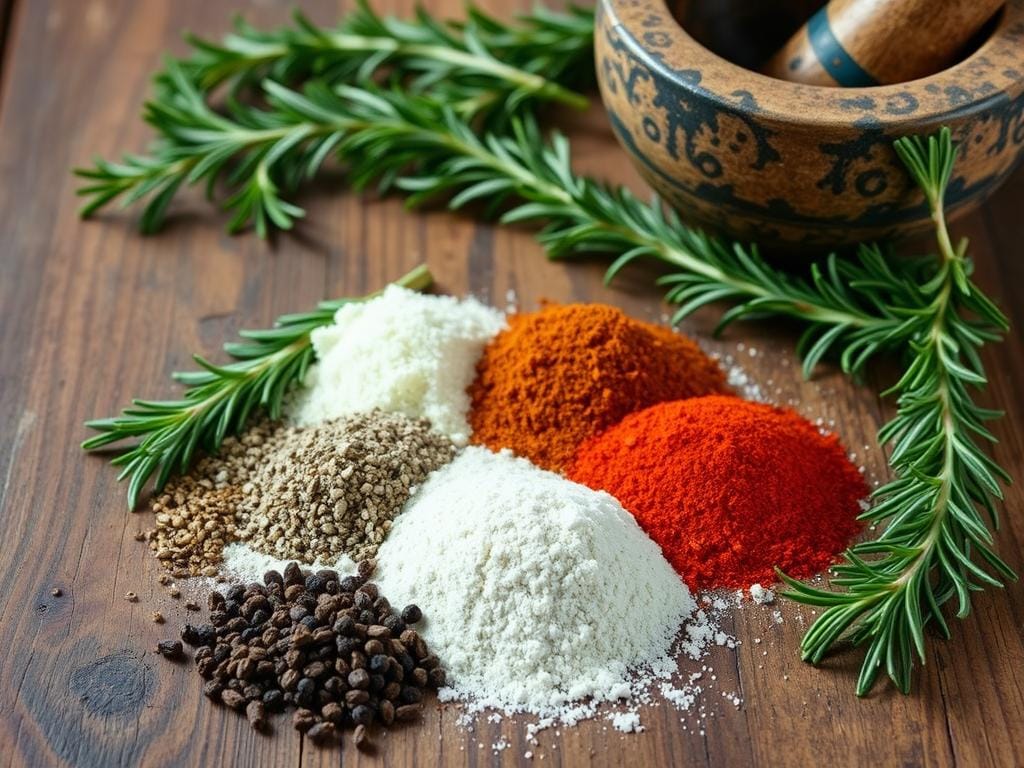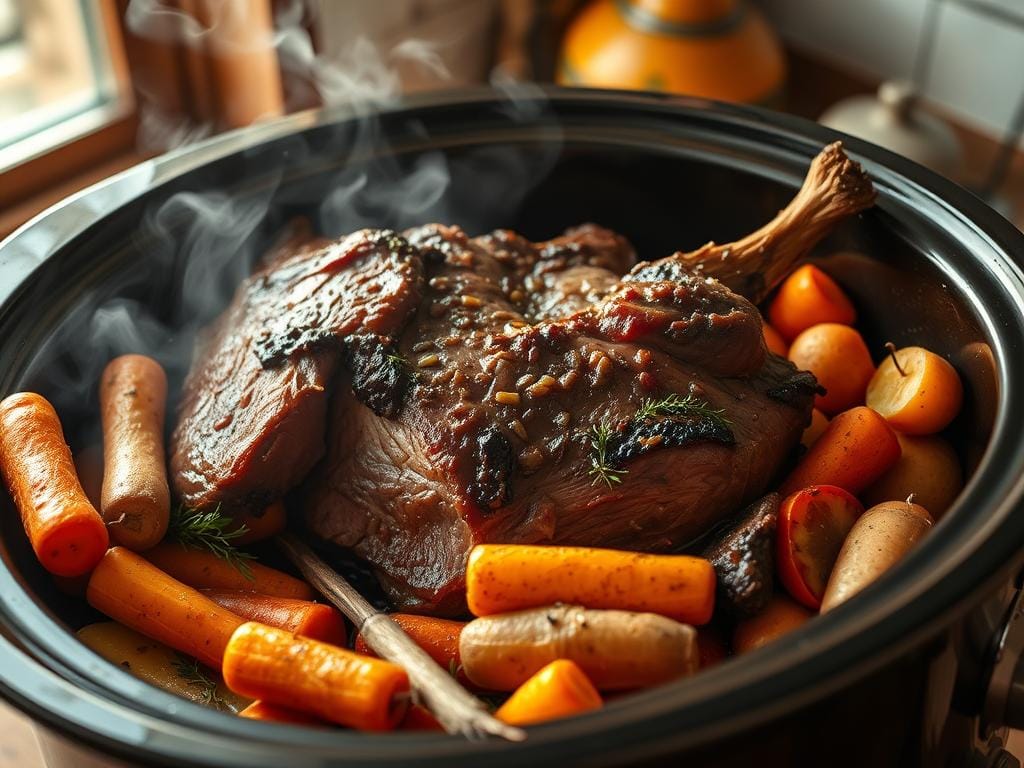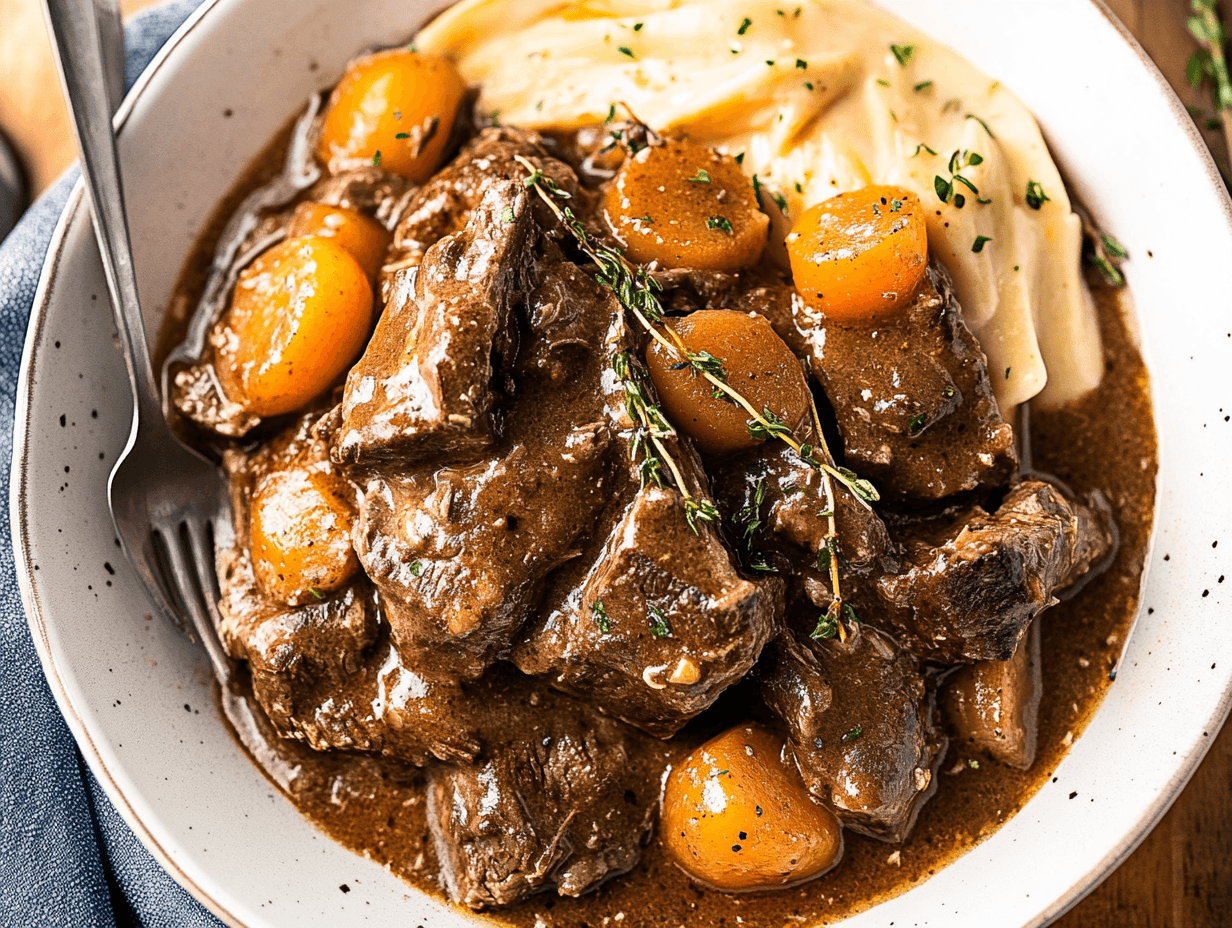As autumn’s chill arrives, nothing beats the smell of slow-cooked venison roast in your home. My grandparents’ farm was our family’s haven. Their hearty meals, made with deer they hunted, always brought us together. The tender, flavorful roast from their slow cooker was a highlight, reminding us of life’s simple joys.
If you love those memories and want to make them in your kitchen, you’re in luck. I’m sharing the best slow cooker venison roast recipe that’s easy, juicy, and perfect every time. It’s great for both seasoned venison lovers and newcomers to this lean, flavorful meat. This recipe is sure to become a family favorite.
Table of contents
- Key Takeaways
- Introduction to Slow Cooker Venison Roast
- Choosing the Right Cut of Venison
- Essential Ingredients for Your Roast
- Preparing Your Venison Roast
- Step-by-Step Cooking Instructions
- Enhancing Flavor with Slow Cooking Techniques
- Serving Suggestions for Venison Roast
- Storing and Reheating Leftovers
- Conclusion and Final Thoughts
- FAQ
Key Takeaways
- This 3-4lb venison roast recipe is perfect for a hearty, yet easy slow-cooked meal.
- The combination of venison stock, balsamic vinegar, and savory spices creates a delicious, tender roast.
- Cooking the roast for 8-9 hours on low heat in a slow cooker or Instant Pot ensures a juicy, fall-apart texture.
- Serve the roast with classic sides like mashed potatoes and roasted vegetables for a complete and satisfying dinner.
- This recipe has received rave reviews, with a 4.82 out of 5 rating from 37 individuals.
Introduction to Slow Cooker Venison Roast
Venison, the lean and flavorful meat from wild deer, is a joy to cook. It’s perfect for tough cuts like the shoulder roast. The slow cooker makes it tender and full of flavor.
What Makes Venison Unique?
Venison is special because it’s lean and has a bold, earthy taste. It’s low in fat, so it can dry out quickly. But the slow cooker fixes this, keeping it juicy and tender.
Benefits of Cooking with a Slow Cooker
- Tenderizes tough cuts: Venison shoulder roasts and other tough cuts benefit greatly from the slow, moist heat of a crockpot, which breaks down the connective tissues.
- Infuses flavors: The long cooking time allows the meat to fully absorb the flavors of the spices, herbs, and other ingredients in the slow cooker.
- Hands-off preparation: Slow cookers require minimal effort, allowing you to set it and forget it while the venison roast cooks to perfection.
- Retains moisture: The enclosed environment of a slow cooker helps to retain the natural juices and moisture in the venison, preventing it from drying out.
Using a slow cooker makes a tender, juicy venison roast. It’s perfect for easy, tasty meals all year round.
Choosing the Right Cut of Venison
Choosing the right cut of venison is key to a delicious roast. Venison is lean and gamey, but some cuts are better for slow cooking. Knowing the best cuts for slow cooking ensures your roast is always juicy and tender.
Popular Cuts for Slow Cooking
- Venison Shoulder Roast or Neck Roast are great for slow cooking. They get tender because of the slow cooking process.
- Bone-in cuts like the Venison Shoulder or Neck add extra flavor while cooking slowly.
- Hind leg roasts, such as the Venison Top Round or Bottom Round, are better for other cooking methods like pastrami or corned venison.
Tips for Selecting Quality Venison
When buying venison, look for dry meat without old blood or discoloration. It should have a deep color and firm texture. Avoid wet packages or strong smells, as they might be of poor quality.
| Venison Roast Cut | Tenderness Level | Best Cooking Method |
|---|---|---|
| Venison Tenderloin | Most Tender | Searing, Grilling, Brief Roasting |
| Venison Backstrap | Very Tender | Searing, Grilling, Brief Roasting |
| Venison Sirloin Tip | Moderately Tender | Roasting, Stewing, Braising |
| Venison Top Round | Less Tender | Roasting, Stewing, Braising |
| Venison Blade Roast | Tough | Braising, Stewing, Simmering |
| Venison Mock Tenderloin | Tough | Braising, Stewing, Simmering |
Understanding each cut’s unique traits is key to a perfect venison roast. With the right cut and cooking method, you’ll enjoy a delicious, tender, and flavorful dish every time.
Essential Ingredients for Your Roast
Making a tasty best venison roast needs the right mix of flavors. For a perfect low and slow venison roast, here are the key ingredients:
Recommended Spices and Seasonings
- Salt: It brings out the venison’s natural taste.
- Dried thyme, dried parsley, and black pepper: These classic spices enhance the meat’s earthy flavors.
- Garlic powder and onion powder: They add depth and a savory taste.
- Worcestershire sauce: It adds a subtle umami flavor.
- Balsamic vinegar: It adds sweetness and a bit of acidity.
Vegetables to Include for Flavor
Adding aromatic vegetables can really boost your venison roast’s taste. Try these:
- Onions: Caramelized onions make the dish sweeter and richer.
- Carrots: They add natural sweetness and a bright color.
- Potatoes: They give the dish substance and a creamy feel.
For even more flavor, mix beef or venison stock with red wine or beer. This creates a rich cooking liquid.

Preparing Your Venison Roast
Preparing your slow cooker venison roast is key to a tender and flavorful dish. We’ll cover thawing, marinating, and prepping the meat for slow cooking.
Thawing and Marinating Tips
Thawing your venison roast properly is essential. Place it in the fridge and let it thaw slowly over 24-48 hours. This method keeps the meat’s quality intact.
After thawing, marinating the venison can boost its taste. A mix of red wine, garlic, and herbs is great. Marinate for 2-4 hours, or up to 24 hours for more flavor.
Prepping the Meat for Cooking
Before slow cooking, prepare the venison roast well. Dry the meat with paper towels to remove moisture and old blood. This helps get a nice sear.
Season the meat with salt and pepper. Rub it with dried herbs and spices like rosemary, thyme, garlic powder, and onion powder for extra flavor.
For the best texture and caramelization, sear the venison in a hot skillet. Then, put it in the slow cooker. This step locks in juices and creates a tasty crust.
By following these steps, you’ll make a delicious slow cooker venison roast. Next, we’ll show you how to cook it for a tasty dinner.
Step-by-Step Cooking Instructions
Preparing a delicious crockpot venison recipe or low and slow venison roast is easy. It results in tender and flavorful meat. Follow these steps to make your venison roast perfect.
Setting Up Your Slow Cooker
Start by putting the seared venison roast in your slow cooker. Add beef or venison broth to cover the meat. Then, sprinkle black pepper, thyme, garlic, and other herbs or spices on top.
Cooking Time and Temperature Guidelines
- Cook the venison roast on low for 8-9 hours for the best tenderness.
- Cooking on high for 4-6 hours works, but it’s not as tender as low and slow.
- For a dutch oven, cook at 285-300°F for 3-5 hours. This makes the meat tender and flavorful.
Patience is key for a tender crockpot venison recipe or low and slow venison roast. Let the meat tenderize slowly in the slow cooker’s moist, flavorful environment.
For more delicious slow-cooked recipes, explore this easy slow cooker cabbage recipe, which pairs wonderfully as a side dish.
Enhancing Flavor with Slow Cooking Techniques
Preparing a delicious venison roast starts with slow cooking. The slow cooker is great for making gamey meat tender. With a few tricks, your dish will taste amazing.
Searing Your Meat Before Cooking
A quick sear in a hot skillet locks in juices and adds a caramelized crust. This step can elevate your dish, much like the techniques used in this easy slow cooker turkey wings recipe.
The Importance of Liquid in Slow Cooking
Slow cooking needs plenty of liquid to keep the meat moist. Use about 1 1/2 cups of flavorful liquid. This can be wine and stock or beer and stock.
Try different liquids to find your favorite taste. You can use red wine or craft beer. There are many options to please everyone.

Mastering searing and choosing the right liquid will make your venison roast a hit. Start experimenting and enjoy the slow cooking magic.
Serving Suggestions for Venison Roast
There are many ways to serve your slow-cooked venison roast. It goes well with traditional side dishes that highlight its rich flavor. Try it with roasted potatoes, buttered carrots, and creamy mashed potatoes for a cozy meal. For something fancier, pair it with slow cooked wild game mushroom risotto or a fresh salad.
Traditional Side Dishes to Pair
- Roasted potatoes
- Buttered carrots
- Mashed potatoes
- Sautéed green beans
- Roasted root vegetables
- Creamy polenta
Creative Leftover Ideas
Don’t waste leftover venison roast! It’s great for making tasty dishes. Try making easy venison dinner tacos or burritos with it. Or, use it in a rich venison ragù, perfect with pasta or polenta. There are many ways to turn your slow cooked wild game into something new and exciting.
| Leftover Venison Dish | Ingredients | Preparation Time |
|---|---|---|
| Venison Tacos | Shredded venison, diced onions, salsa, shredded cheese, tortillas | 15 minutes |
| Venison Ragù | Diced venison, crushed tomatoes, garlic, onions, herbs, red wine | 45 minutes |
| Venison Shepherd’s Pie | Shredded venison, mashed potatoes, frozen mixed vegetables | 1 hour |
Storing and Reheating Leftovers
Proper storage and reheating are key to keeping your slow cooker venison roast tender and flavorful. Follow these tips to keep your leftovers fresh and tasty.
Best Practices for Refrigeration
After your venison roast cools, put leftovers in airtight containers or plastic bags. This keeps moisture in and prevents drying. Refrigerate them quickly, as they last 3-4 days in the fridge.
Reheating Tips for Optimal Flavor
To reheat your tender venison roast without drying it out, use gentle heat. Add a bit of broth or water to the container. Then, reheat it on the stovetop or in the oven at a low temperature.
Try using leftover slow cooker venison roast in different dishes. You can make venison tacos, a hearty stew, or a rich pasta ragù. The options are endless with such flavorful meat.
By using these simple storage and reheating methods, you can enjoy your tender venison roast for days. Take care to keep it juicy and tender, making it hard to resist.
Conclusion and Final Thoughts
This slow cooker venison roast recipe is a surefire way to get tender, tasty results. By picking the right cut, seasoning it well, searing it first, and then slow cooking, you’ll get a delicious venison dinner. You can also try different seasonings and liquids to make your dish unique.
Recap of Key Cooking Tips
Choose the right venison cut for slow cooking, like shoulder or rump. Seasoning it right and searing it before slow cooking makes it even better. Don’t forget to check the meat’s temperature and let it rest before slicing for the best taste and texture.
Encouragement to Experiment with Venison
Once you get the hang of slow cooker venison roast, try new flavors and methods. Venison’s strong taste goes well with many spices, herbs, and sides. Be bold and create your own special venison dishes that will wow everyone.
For alternative slow-cooked inspirations, don’t miss this easy Jezebel chicken crockpot recipe for a unique twist on classic comfort food.
FAQ
What Vegetables Should Not Be Added to a Slow Cooker?
Not all vegetables are ideal for slow cooking because their texture, flavor, or nutrient content may change undesirably. Here are some examples:
- Delicate Vegetables
- Leafy greens like spinach, lettuce, or arugula tend to wilt and lose their texture.
- These vegetables should be added towards the end of cooking for a fresher taste.
- Crisp Vegetables
- Vegetables like broccoli, asparagus, or zucchini may become mushy if cooked for too long.
- It’s better to steam or blanch them separately and add them just before serving.
- High-Moisture Vegetables
- Cucumbers and summer squash contain a lot of water, which can dilute the flavor of your dish.
- Certain Root Vegetables
- Potatoes, carrots, and parsnips can be slow-cooked, but they may need to be cut into smaller pieces or pre-cooked to ensure even cooking.
Why Do You Soak Cabbage Before Cooking?
Soaking cabbage before cooking serves several purposes:
- Removing Dirt and Debris
- Outer leaves of cabbage can trap dirt or insects. Soaking ensures these are removed.
- Reducing Bitterness
- Some varieties of cabbage, like green or Savoy, can taste bitter. Soaking in cold water helps mellow the flavor.
- Improving Texture
- Soaking cabbage for a short time can make the leaves more pliable and easier to handle, especially for recipes like stuffed cabbage rolls.
- Cleansing Residual Pesticides
- For non-organic cabbage, soaking can help reduce surface residues.
Is There a Difference Between a Crockpot and a Slow Cooker?
Yes, there are differences, though the terms are often used interchangeably:
- Brand Name vs. Appliance Type
- A Crockpot is a brand of slow cookers manufactured by Sunbeam Products.
- A slow cooker is a general term for appliances used for low-temperature cooking over a long period.
- Heating Mechanism
- Crockpots: Have a ceramic pot surrounded by a heating element that provides consistent, even heat.
- Slow Cookers: Often have a metal pot with the heating element at the base, leading to slight variations in heat distribution.
- Usage and Features
- Both are used for similar recipes, but crockpots are designed for even cooking, making them ideal for dishes like stews, soups, and roasts.
- Slow cookers may offer more settings and versatility, depending on the brand and model.
What Cannot Be Cooked in a Slow Cooker?
While a slow cooker is versatile, certain foods are not well-suited:
- Dairy Products
- Milk, cream, or cheese can curdle over long cooking times. Add these near the end of cooking.
- Seafood
- Fish and shrimp cook quickly and can overcook, becoming rubbery in a slow cooker.
- Crispy Foods
- Foods like fried chicken or items meant to retain crunch will lose their texture.
- Pasta and Rice
- These ingredients may become overcooked or mushy if added at the start. Pre-cooking them separately is recommended.
- Alcohol
- Since the slow cooker doesn’t reach a high enough temperature to evaporate alcohol, it can leave a strong, unpleasant flavor in dishes.
- Certain Spices
- Delicate herbs like parsley, basil, and cilantro can lose their flavor when cooked for long durations. Add these at the end for the best results.

